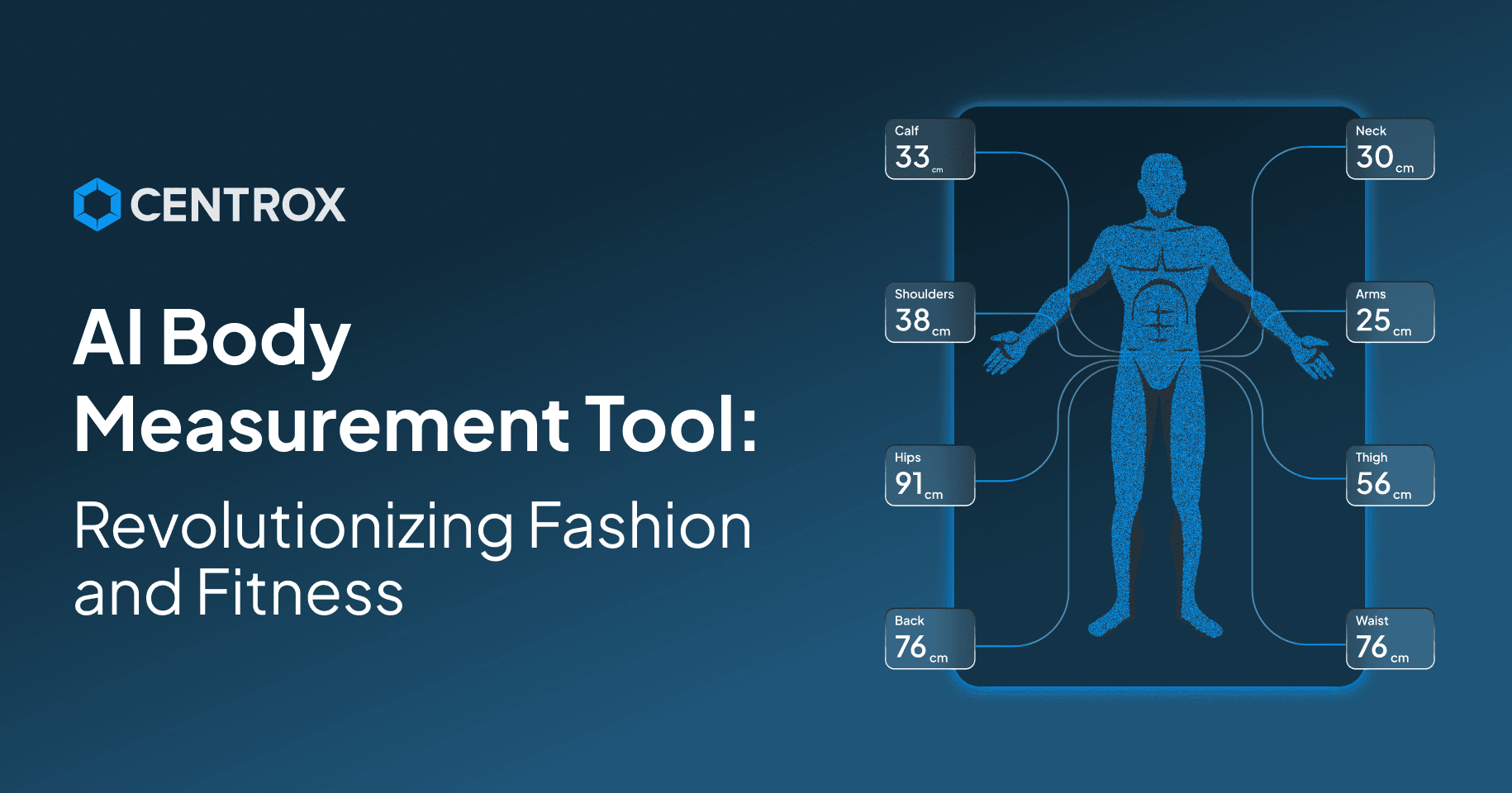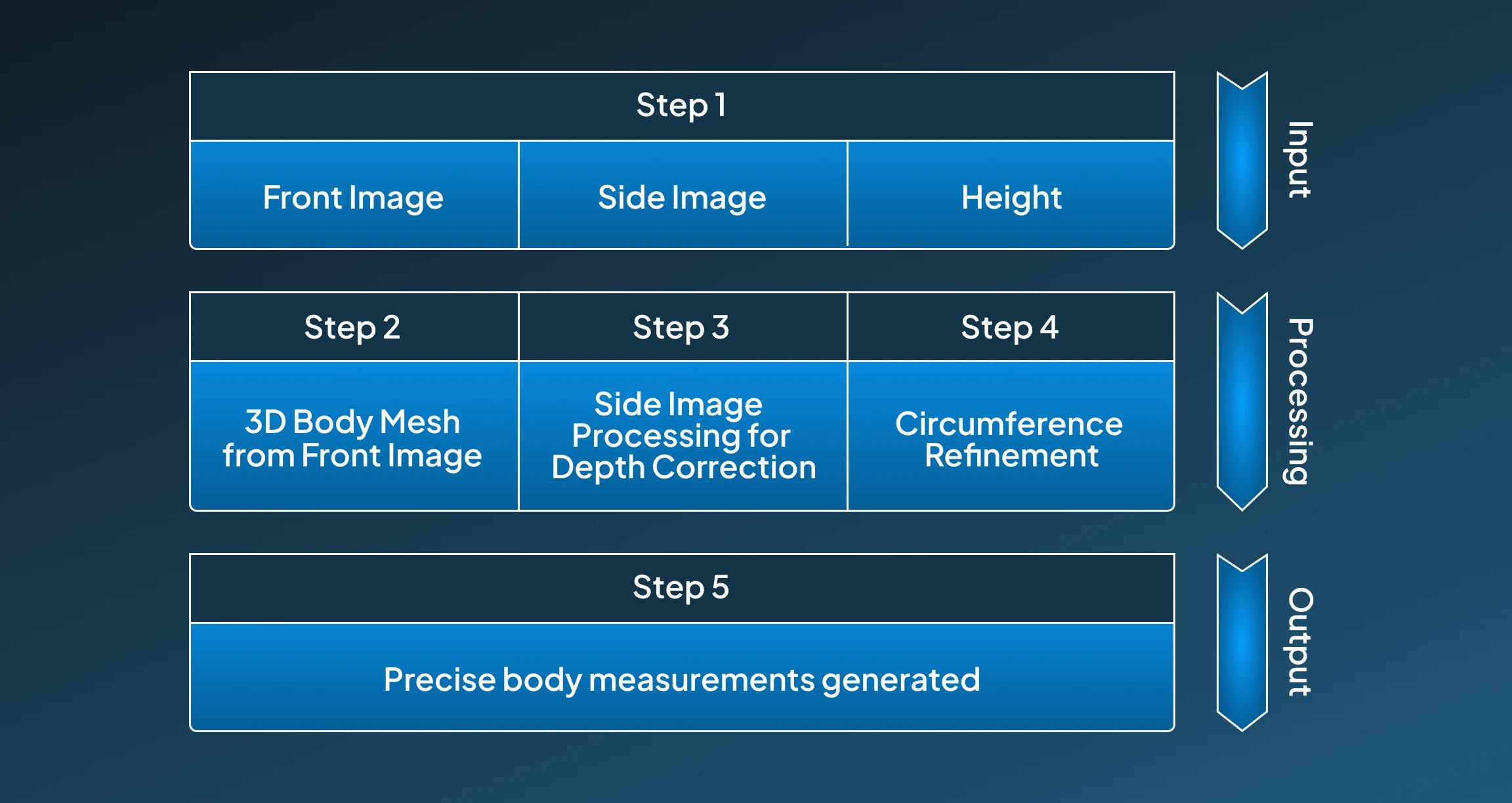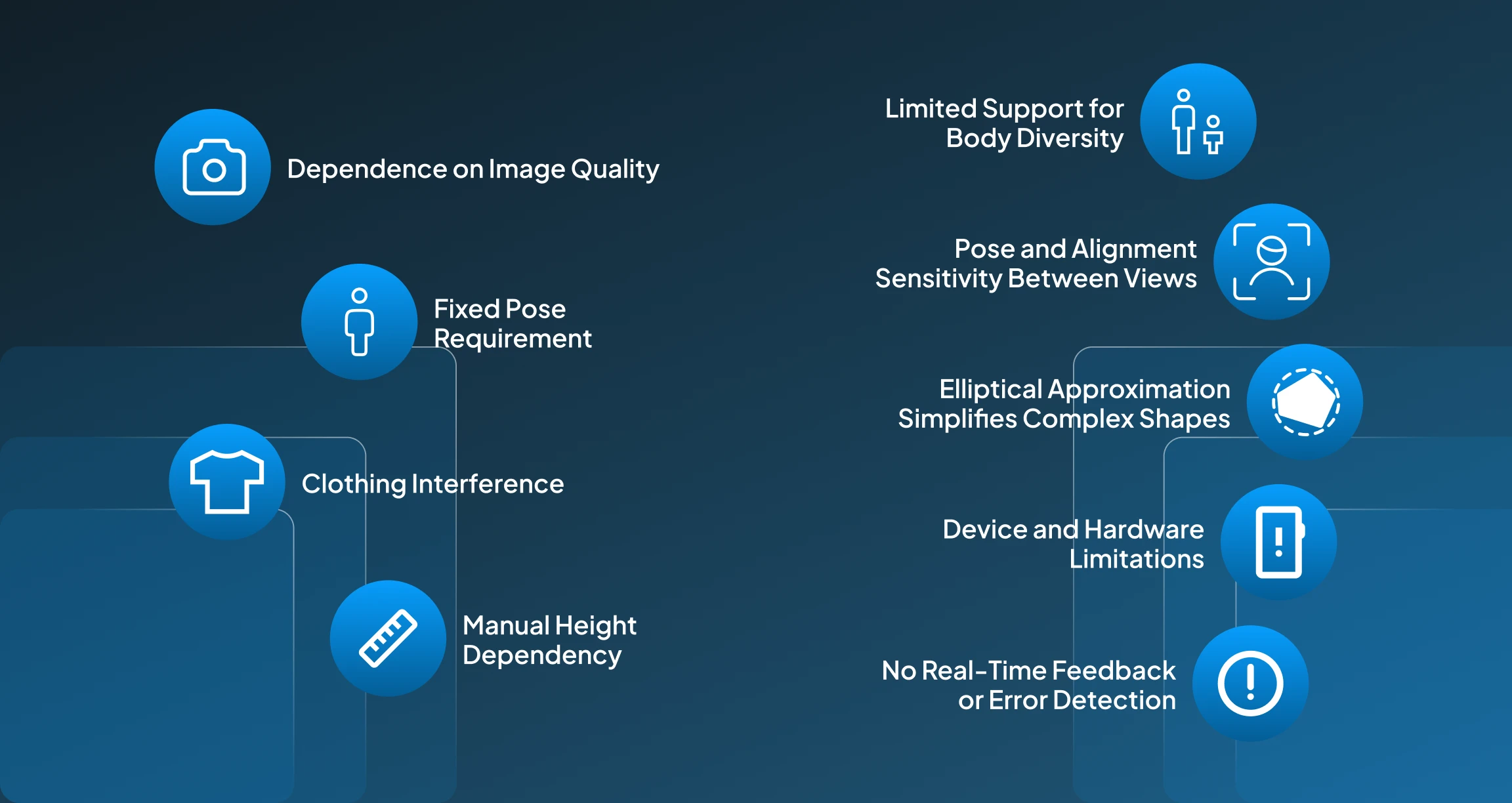AI Body Measurement Tool: Revolutionizing Fashion and Fitness
Find how AI body measurement tool works for fashion and fitness, along with their benefits and limitations, to help you include it efficiently in your business.
7/4/2025
artificial intelligence
11 mins

AI is now spreading everywhere to join convenience with daily workflow requirements. Who would have thought that a few years back that with growing advancements in the space of AI, we would be facilitated with applications that could intelligently measure bodies without needing to be physically present there for measurement.
Such advancements are not just enabling ease but also enhancing the accessibility of business services that need measurements for providing products with proper sizing beyond traditional accessibility boundaries. This eliminates the need to perform in-person measurements, making the product or service delivery process faster.
With our article, we will help you build your basic understanding of the AI body measurement tool, and how this AI body measurement tool works, some problems it solves, and we will also learn about the limitations of this tool. So that you have a deeper insight into how it can be valuable for your business.
What is the AI Body Measurement Tool?
An AI body measurement tool is basically an AI-enabled tool that helps you take measurements of humans virtually. It utilizes some machine learning and computer vision techniques to accurately measure the required body from the provided input image. Thus, it makes measurement and production faster and smarter.
So, AI is now making a move to not only assist but become a dependable support for your everyday work or casual responsibilities. If we hear it in the words of Andrew Ng( co-founder of Google Brain), he describes AI as:
“AI is the new electricity. Just as electricity transformed almost everything 100 years ago, today I actually have a hard time thinking of an industry that I don’t think AI will transform in the next several years.”
This statement reflects the ability of AI to power industry applications and efficiently revolutionize traditional practices by introducing an intelligent, fast, and reliable alternative.
How does the AI Body Measurement Tool work?
Before diving deep into understanding its usefulness and impacts in application, it is extremely important to learn how this AI body measurements tool works to help you receive accurate measurements for your requirements. This procedural breakdown will help you understand the workflow running behind the tool, so that you can further fine-tune and optimize it according to your desired application. Below, we have provided the procedural breakdown for our AI body measurement tool:

Step 1: Input Acquisition
The process for AI body measurement begins with asking the user to provide a relevant image as input. Below, we have listed the particular things we require from the user before initiating the process of AI-driven measurement:
- Front Image: This AI body measurement tool requires a clear, front-facing photo of the person in a standard pose (typically standing straight with arms relaxed) as input.
- Side Image: Then it also needs a side-view image to provide depth information, especially for body thickness, to provide accurate measurements for the chest or belly.
- Height: This tool either requires users to manually enter their height or it is estimated through a depth map. This value is a critical point for scaling the 3D model to real-world proportions.
Step 2: 3D Body Mesh from Front Image
After acquiring the image provided by the user as input, the provided front image is processed through a 3D body mesh to calculate the measurements from it. The functioning of the 3D body mesh is broken down below:
SMPL Mesh Generation
The provided front image is processed using models like HMR, HMR2.0, or CLIFF to generate a SMPL (Skinned Multi-Person Linear) 3D human mesh. This SMPL model provides 6890 mesh vertices that represent the entire body surface, and also provides 2D and 3D keypoints such as shoulders, elbows, hips, etc.
Control Points
The method provides a mesh from the SMPL model that chooses some particular vertices that act as anatomical landmarks. These include the chosen vertices are shoulders, waist, chest, hips, and wrists. These control points contribute to calculating accurate dimensions of the human body.
Measurement Estimation
This AI body measurement tool uses Euclidean distance or fitted curves on the mesh surface, which helps this AI-drien tool to accurately measure the following points:
- Height: The height of a given object is measured by scaling the model vertically using the user's actual height.
- Shoulder Width: To find out the shoulder width, we calculate the horizontal distance between the left and right shoulder points.
- Chest, Waist, and Hip Circumferences: The estimated measurements for chest, waist, and hip circumference are provided by using the frontal contour around those regions.
Step 3: Side Image Processing for Depth Correction
Then, for further deriving the most appropriate measurements, the side image provided by the user is processed. To help you out in understanding how the side image is processed for depth correction, we have briefly explained to you the steps involved below:
Keypoint Detection
For identifying the keypoints, models like MediaPipe are utilized, which helps in finding out major joints and landmarks like: shoulder, hip, and knee from the provided side image.
Segmentation
The AI body measurement tool then segments the body outline from head to toe, by isolating the important regions like: chest, waist, belly, and hips
Depth Line Construction
At each anatomical level (e.g., chest, waist), horizontal lines are drawn across the body in the side image. These drawn lines provide an estimation of depth (front-to-back thickness), which isn't available in the front view.
Step 4: Circumference Refinement
After receiving the initial calculated measurements, in the next step, we further refine these measurements to get more realistic measurements. This process of refinement is done by:
- Combining Width (w) from the front-view mesh with Depth (d) from the side-view image
- Fit an elliptical or cylindrical model to approximate the shape of body parts
Then we have applied the formula for elliptical circumference approximation:
C ≈ π × [ 3(w + d) – √((3w + d)(w + 3d)) ]
This contributes significantly to improving the accuracy for measuring circular body regions like the belly, chest, and hips.
Step 5: Final Output
After performing processing on both the views and scaling them using the real height, the system returns precise body measurements that include the following results:
- Waist circumference: Around the narrowest part of the torso.
- Belly circumference: Measured at the widest part of the abdomen (slightly below the waist).
- Chest circumference: Horizontal circumference across the fullest part of the chest.
- Wrist circumference: Around the thinnest part of the wrist.
- Neck circumference: Circumference measured around the base of the neck.
- Arm length: From the shoulder joint to the wrist, along the outside of the arm.
- Thigh circumference: Circumference around the thickest part of the upper leg.
- Shoulder width: Distance between the outer points of both shoulders.
- Hip circumference: Around the widest part of the hips and buttocks.
- ankle_circumference: Around the narrowest part of the ankle.

Common Fit Problem Solved by AI Body Measurement Tool
This AI body measurement tool is a dream solution for businesses, as this single solution efficiently addresses various common problems that businesses face related to sizing and measurements for their everyday workflows. Some commonly faced measurement problems which is solved by this AI body measurement tool are listed below:
1. Inaccurate Manual Measurements
The conventional practices for measurements are prone to human error. An AI body measurement tool can be a useful and user-friendly tool that provides precise and accurate measurements using images or videos as input.
2. High Product Return Rates (Especially in Fashion E-Commerce)
Incorrect sizing is one of the major reasons for product returns to the service provider. Our AI body measurement tool addresses this concern for businesses as it allows customers to find the perfect fit that matches the required measurements, and eventually helps in reducing the product return rates.
3. Lack of Personalization in Fit Recommendations
By implementing this AI body measurement tool in your e-commerce website, you can allow users to analyze body shapes and dimensions, and eventually provide personalized recommendations for clothing products or a customized fitness plan, which elevates customer trust and satisfaction.
4. Time-Consuming Measurement Processes
The traditional method of taking measurements manually is a time-consuming process that often requires you to take professional help. An AI-driven body measurement tool can easily perform this job by taking an image or scanning the body and delivering precise and accurate measurements instantly.
5. Limited Accessibility to Professional Tailoring or Fit Services
People in remote or rural areas might not have access to professional-grade body measurements. In such a scenario, our AI body measurement tool provides a solution that allows user to get accurate measurements of their body or objects from anywhere around the world. This reduces fit inconsistencies and helps you find the perfect size.
6. Difficulty in Tracking Fitness Progress
Fitness users can track subtle body changes over time with this AI body measurement tool, helping them stay motivated and informed about their progress and plan their fitness routine accordingly.
7. Inconsistent Sizing Standards Across Brands
AI can bridge the gap between different brand sizing charts by mapping individual measurements to standardized or brand-specific sizes, contributing to enhancing the customer experience.
8. Uncomfortable In-Person Measurement Sessions
The conventional practice for body measurement is often uncomfortable for some users. This AI body measurement tool allows a contactless and private body measurements, enhancing user comfort and privacy.
Limitations of the AI Body Measurement Tool
Despite helping in providing fast, convenient, and reliable measurements, this AI body measurement tool holds its share of limitations, which is important for you to know. So that you can plan accordingly before implementing it for your business application. Below, we have provided you with an overview of the limitations of the AI body measurement tool:

1. Dependence on Image Quality
Low-resolution or blurry images can significantly downgrade mesh accuracy and keypoint detection. Also, Poor lighting, shadows, or improper pose (e.g., bent arms, tilted posture) might lead to introducing errors in both front and side images.
2. Fixed Pose Requirement
The tool relies on a standardized pose (arms relaxed, body straight). If there are deviations from this pose, then it can distort the mesh or cause misalignment of control points, especially for measurements like shoulder width or arm length.
3. Clothing Interference
Loose, thick, or non-form-fitting clothing may cause segmentation inaccuracies and distort the body outline. This particularly affects waist, belly, and thigh circumference measurements.
4. Manual Height Dependency
If the user's height is entered incorrectly, all scaled measurements will be proportionally inaccurate. The tool lacks built-in height validation unless paired with a calibrated device or reference object.
5. Limited Support for Body Diversity
SMPL-based models are trained on standard body types and may not fully capture variations such as:
- Highly muscular physiques
- Obese or extremely slim body shapes
- Physical deformities or prosthetics
6. Pose and Alignment Sensitivity Between Views
Any inconsistency in posture or camera angle between the front and side images (e.g., leaning forward in the side image) can lead to depth mismatch and inaccurate circumference refinement.
7. Elliptical Approximation Simplifies Complex Shapes
Approximating body cross-sections as ellipses or cylinders may ignore nuances in human anatomy (e.g., asymmetry, muscular bulges), reducing precision for applications like tailoring or medical assessments.
8. Device and Hardware Limitations
Smartphones without advanced cameras (such as depth sensors or wide-angle lenses) may yield lower-quality inputs, impacting overall measurement accuracy.
9. No Real-Time Feedback or Error Detection
The system may not notify users of improper poses, poor lighting, or bad framing. Lack of real-time correction can result in repeated attempts or inaccurate final results without the user realizing the issue.
Conclusion
The AI Body Measurement Tool isn't just transforming the way we approach sizing, fit, and personalization in industries like fashion and fitness; it's also helping us explore new possibilities that AI can bring. By utilizing an innovative approach of combining front and side images with 3D mesh modeling, control point estimation, and elliptical refinement techniques, it helps businesses receive accurate, contactless body measurements.
Although it is offering impressive benefits, such as reduced return rates, personalized fitting, and virtual try-ons, it still holds some limitations around pose sensitivity, device quality, and clothing interference. However, with ongoing research in AI and computer vision, this technology holds strong potential to become a standard tool for both consumers and businesses seeking intelligent, more efficient body measurement solutions.
Looking to upscale your fashion, fitness, or retail business with an AI-driven measurement tool? Get in touch with our experts at Centrox AI, and we will provide a customized plan for implementing this amazing solution for your business needs.

Muhammad Harris
Muhammad Harris, CTO of Centrox AI, is a visionary leader in AI and ML with 25+ impactful solutions across health, finance, computer vision, and more. Committed to ethical and safe AI, he drives innovation by optimizing technologies for quality.
Do you have an AI idea? Let's Discover the Possibilities Together. From Idea to Innovation; Bring Your AI solution to Life with Us!
Your AI Dream, Our Mission
Partner with Us to Bridge the Gap Between Innovation and Reality.
